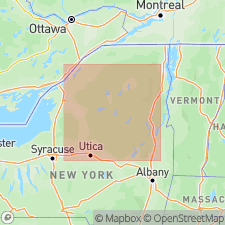
- Usage in publication:
-
- Treadway Mountain Formation
- Modifications:
-
- Overview
- Dominant lithology:
-
- Gneiss
- AAPG geologic province:
-
- Adirondack uplift
Summary:
The informal Treadway Mountain Formation of Walton and deWaard (1963) is here used and assigned to the Lake George Group in the eastern Adirondacks in NY. It consists of migmatitic biotite-quartz-plagioclase gneiss, quartz-rich graphite-garnet-sillimanite gneiss, quartzite, and garnet-biotite gneiss. Overlies the Paradox Lake Formation; underlies the Barton Mountain Formation. In the central Adirondacks, biotitic and garnetiferous rocks similar to the Treadway Mountain are present in the Lake Durant Formation, suggesting that the Treadway Mountain may be present but thinner in the central Adirondacks. Correlates with the Pleasant Lake Gneiss of the northwestern Adirondacks. Age is Proterozoic.
Source: GNU records (USGS DDS-6; Reston GNULEX).
For more information, please contact Nancy Stamm, Geologic Names Committee Secretary.
Asterisk (*) indicates published by U.S. Geological Survey authors.
"No current usage" (†) implies that a name has been abandoned or has fallen into disuse. Former usage and, if known, replacement name given in parentheses ( ).
Slash (/) indicates name conflicts with nomenclatural guidelines (CSN, 1933; ACSN, 1961, 1970; NACSN, 1983, 2005, 2021). May be explained within brackets ([ ]).

